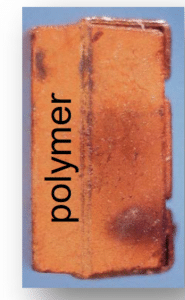
Reliability Issues with Polymer and MnO2 Tantalum Capacitors
- Posted by doEEEt Media Group
- On January 25, 2021
- 0
for Space Applications
Alexander Teverovsky, Jacobs Engineering, Inc, NASA GSFC published a presentation that provides a comparative analysis of degradation processes, failure modes and mechanisms in MnO2 and polymer technology tantalum capacitors. Analyzed conditions include effects of vacuum and radiation, soldering (pop-corning), long-term storage, operation at high temperatures, stability at low and high temperatures, and anomalous transients. Screening and qualification procedures to assure the space-grade quality of conductive polymer tantalum capacitors (CPTCs) are suggested.

Breakdown failure mode of MnO2 tantalum capacitor
Advantages and Disadvantages of Conductive Polymer Tantalum Capacitors for Space Applications

The breakdown failure mode of a polymer tantalum capacitor
Effect of Moisture
- CPTCs are more sensitive to moisture compared to MnO2 caps.
- Capacitance variations can reach 40% and DCL >10^4times.
Failures after Soldering
- Pop-corning, due to moisture increases delamination, introduces cracks in the package and might damage Ta2O5 dielectric.
- Cracks in packages facilitate penetration of oxygen that increases the rate of ESR degradation in CPTCs.
- Damage to dielectric causes first power-on failures in MnO2 capacitors. The effect has not been observed yet in CPTCs.
- Damage caused by soldering is lot-related.
- Pop-corning issues can be resolved by baking.
- Requirements for MSL testing should include measurements of ESR and surge current testing.
- Decrease of C in CPTCs is greater than in MnO2 capacitors.
- Soldering increases ESR in most types of capacitors, but the level of variations is lot-related.
- Soldering results in drying off capacitors by 50 to 93%
Effect of Vacuum
Drying in a vacuum has a similar effect as drying in the air:
- Decreasing of capacitance and DF;
- A relatively small changes in ESR;
- Variations of C and DF with V;
- Increasing of transient leakage currents, especially at low T.
Life Testing of Tantalum Polymer Capacitors
- No catastrophic failures during life testing and SSLT in 23 lots.
- CPTCs can operate reliably at high T at steady-state conditions.
- Increasing leakage currents with time is similar to MnO2 caps.
- Post-test DCL measurements might fail the limit.
- Erratic behaviour of currents in some samples/lots.
Recommendation for Specification & Qualification
General:
- CPTCs should be preconditioned before qualification testing.
- Life testing, HTS, and TS should be carried out using capacitors soldered per specified MSL.
- Testing for FR is not necessary for the following reasons:
- Field failures rarely happen at life test conditions;
- Uncertainty in AFs creates orders of magnitude errors in FR;
- Due to derating, actual FRs are orders of magnitude below the mission requirements;
- Most microcircuits that have been successfully used for space are non-ER components.
Screening (Gr.A) should include:
- Surge current testing. The existing MIL-PRF-55365 requirements limiting maximum current after 1 mseccan be used for CPTCs.
- Burning-in at 105 ºC 1.1VR for 40 hours.
LAT (or gr. B qualification test) should include:
- Life testing at 105 ºC, 1.1VR for 1000 hr.
- High-temperature storage test, 1000 hrat 125 ºC.
- Thermal shock, 100 cycles between -55 and +125 ºC.
- Testing after baking at 125 ºC for 168 hours:
- Surge current test at -55 ºC, 25 ºC, and +85 ºC.
- Stability at low and high temperatures (including DCL at low temperatures).
- Power cycling 100 cycles at RT and 0.75VR (5 sec ON/OFF using a power supply capable of rising voltage is less than 1 msec).
Source: NEPP.NASA.GOV
- Space-Grade components available for immediate delivery - April 10, 2025
- Exclusive stock on doEEEt: How to access and request - April 10, 2025
- Managing EEE components for LEO and lower cost space missions - December 17, 2024

0 comments on Reliability Issues with Polymer and MnO2 Tantalum Capacitors